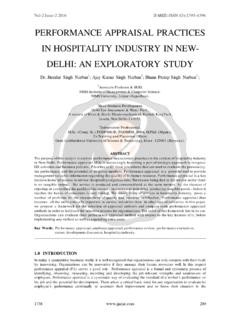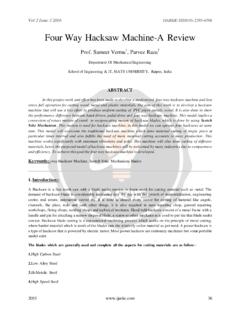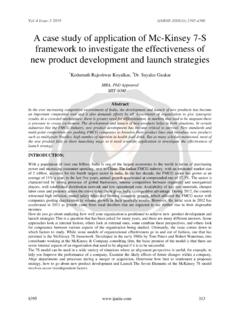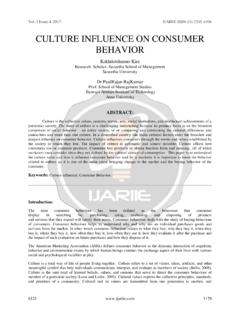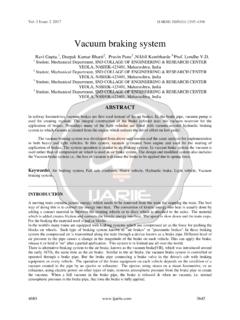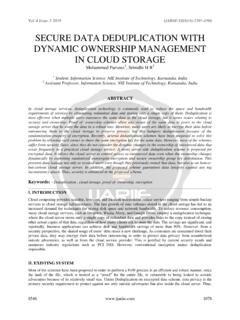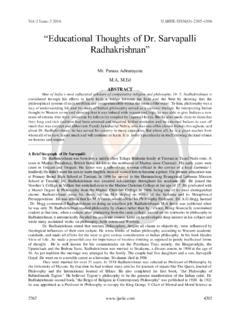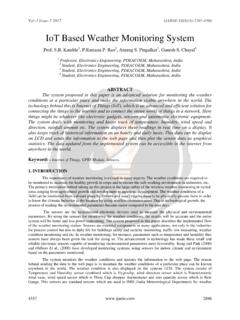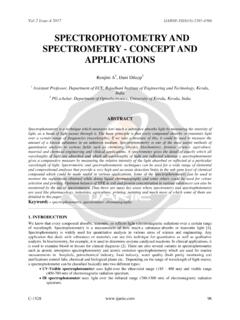Transcription of CITRIC ACID PRODUCTION FERMENTATION PROCESS
1 Vol-3 Issue-2 2017 IJARIIE-ISSN(O)-2395-4396 4728 3983 CITRIC ACID PRODUCTION FERMENTATION PROCESS Tushar Patel1, Hiral Pandya2 1 Student, Chemical Engineering Department, college of Engineering, Gujarat, India 2 Assistant Professor, Chemical Engineering Department, college of Engineering, Gujarat, India ABSTRACT CITRIC acid is the most important organic acid produced in tonnage and is extensively used in food and pharmaceutical industries. It is produced mainly by submerged FERMENTATION using Aspergillus niger or Candida sp. from different sources of carbohydrates, such as molasses and starch based media. However, other FERMENTATION techniques, solid state FERMENTATION and surface FERMENTATION , and alternative sources of carbon such as agroindustrial residues have been intensively studied showing great perspective to its PRODUCTION . This paper reviews recent developments on CITRIC acid PRODUCTION by presenting a brief summary of the subject, describing microorganisms, PRODUCTION techniques, and substrates, etc.
2 Keywords: CITRIC acid PRODUCTION , Aspergillus niger, surface FERMENTATION , solid state FERMENTATION , Submerged FERMENTATION 1. INTRODUCTION: CITRIC acid FERMENTATION was first observed as a fungal product by Wehmer in 1893 by a culture of Penicillium glaucum on sugar medium. After a few years, he isolated two new fungal strains with the ability to accumulate CITRIC acid, which were designated Citromyces (Penicillium). However, industrial trials did not succeed due to contamination problems and long duration of FERMENTATION . It was the work of Currie which opened up the way for successful industrial PRODUCTION of CITRIC acid. In 1916, he found that numerous strains of Aspergillus niger produced significant amounts of CITRIC acid. The most important finding was that Aspergillus niger grew well at pH values around and high concentrations of sugars favour CITRIC acid PRODUCTION . [1] The first CITRIC acid fermentations were carried out in surface cultures.
3 In the 1930s, some units were implanted in England, in Soviet Union, and in Germany for the commercial PRODUCTION . In general, CITRIC acid is commercially produced by submerged microbial FERMENTATION of molasses; the FERMENTATION PROCESS using Aspergillus niger is still the main source of CITRIC acid worldwide. Although methods were well developed to synthesise CITRIC acid using chemical means, better successes were achieved using microbial fermentations, and over the period of time, this technique has become the method of ultimate choice for its commercial PRODUCTION over chemical synthesis. Despite that, the introduction of submerged FERMENTATION presented several problems, including the choice of productive strains with low sensitivity to trace elements. It was necessary to consider raw material much more carefully. Several works were dedicated to the optimization of the conditions for the utilization of cheap material like sugar cane molasses, beet molasses, starch and hydrolysate starch.
4 Various processes for treating and purifying molasses were developed, especially for the removal of trace metals. Moreover, it was found that a small excess of copper ions was beneficial to achieve high yields of CITRIC acid. [2] There are annual growths of % in demand/ consumption of CITRIC acid. In the last years, a considerable interest has been shown in using agricultural products as alternative sources of carbon and their wastes such as maize, apple and grape pomace, pineapple, mandarin orange and brewery wastes, citrus and kiwi fruit peel for CITRIC acid PRODUCTION by Aspergillus niger. The industry is seeking newer cheap and economic PROCESS technology. 2. APPLICATIONS OF CITRIC ACID: CITRIC acid is mainly used in food industry because of its pleasant acid taste an its high solubility in water. It is worldwide accepted as GRAS (generally recognized as safe), approved by the Joint FAO/WHO Expert Committee on Food Additives.
5 The pharmaceutical and cosmetic industries retain 10% of its utilization and the remainder is used for various other purposes. Table 1 presents main applications of CITRIC acid. Vol-3 Issue-2 2017 IJARIIE-ISSN(O)-2395-4396 4728 3984 Table 1: Applications of CITRIC Acid Industry Applications Beverages Provides tartness and complements fruits and berries flavours. Increases the effectiveness of antimicrobial preservatives. Used in pH adjustment to provide uniform acidity. Jellies, Jams and Preserves Provides tartness. pH adjustment. Candy Provides tartness. Minimizes sucrose inversion. Produces dark colour in hard candies. Acts as acidulant. Frozen fruit Lowers pH to inactivate oxidative enzymes. Protects ascorbic acid by inactivating trace metals Dairy products As emulsifier in ice creams and processed cheese; acidifying agent in many cheese products and as an antioxidant.
6 Fats and oils Synergist for other antioxidants, as sequestrate. Pharmaceuticals As effervescent in powders and tablets in combination with bicarbonates. Provides rapid dissolution of active ingredients. Acidulant in mild astringent formulation. Anticoagulant. Cosmetics and toiletries pH adjustment, antioxidant as a metallic ion chelator, buffering agent. Industrial applications Sequestrant of metal ions, neutralizing, buffer agent Metal cleaning Removes metal oxides from surface of ferrous and nonferrous metals, for preparational and operational cleaning of iron and copper oxides 3. MICRO-ORGANISMS USED FOR CITRIC ACIC PRODUCTION : A large number of micro-organisms including bacteria, fungi and yeasts have been employed to produce CITRIC acid. Most of them, however, are not able to produce commercially acceptable yields. This fact could be explained by the fact that CITRIC acid is a metabolite of energy metabolism and its accumulation rises in appreciable amounts only under conditions of drastic imbalances.
7 The strains reported to produce CITRIC acid. Table 2 shows the micro-organisms used to produce CITRIC acid. Among these, only A. niger and certain yeasts such as Saccharomycopsis sp. are employed for commercial PRODUCTION . However, the fungus A. niger has remained the organism of choice for commercial PRODUCTION . The main advantages of using this microorganism are: (a) its ease of handling, (b) its ability to ferment a variety of cheap raw materials, and (c) high yields. [3] Table 2: Micro-organisms employed for CITRIC acid PRODUCTION Micro-organisms References Fungi Aspergillus niger Hang & Woodams 1984, 1985, 1987, Roukas 1991, Garg & Hang 1995, Pintado 1998, Vandenberghe 1999 A. aculeatus El Dein & Emaish, 1979 A. awamori Grewal & Kalra, 1995 A. carbonarius El Dein & Emaish, 1979 A. wentii Karow & Waksman, 1947 Karow & Waksman, 1947 A. foetidus Chen, 1994; Tran et al., 1998 Penicillium janthinelum Grewal & Kalra, 1995 Yeasts Candida tropicalis Kapelli et al.
8 , 1978 C. oleophila Ishi et al., 1972 C. guilliermondii Miall & Parker, 1975; Gutierrez et al., 1993 C. parapsilosis Omar & Rehm, 1980 C. citroformans Uchio et al., 1975 Hansenula anamola Oh et al., 1973 Bacteria Bacillus licheniformis Sardinas, 1972 Vol-3 Issue-2 2017 IJARIIE-ISSN(O)-2395-4396 4728 3985 Arthrobacter paraffinens Kroya FERMENTATION Industry, 1970 Corynebacterium sp. Fukuda et al., 1970 T 4. PRODUCTION TECHNIQUES AND RAW MATERIALS: Although CITRIC acid is mostly produced from starch or sucrose based media using liquid FERMENTATION , a variety of raw materials such as molasses, several starchy materials and hydrocarbons have also been employed. Classified raw materials used for CITRIC acid PRODUCTION in to two groups: [4] I. Raw materials with a low ash content from which the cations could be removed by standard procedures ( cane or beet sugar, dextrose syrups and crystallized dextrose); II.
9 Raw materials with a high ash content and high amounts of other non-sugar substances ( cane and beet molasses, crude unfiltered starch hydro-lysates). Several attempts have been made to produce CITRIC acid using molasses, which is preferred due its low cost and high sugar content (40-55%). The composition of molasses depends on various factors, the kind of beet and cane, methods of cultivation of crops and fertilizers and pesticides applied during cultivation, conditions of storage and handling ( transport, temperature variations), PRODUCTION procedures, etc. Both, cane and beet molasses are suitable for CITRIC acid PRODUCTION . However, beet molasses is preferred due to its lower content of trace metals. Generally, cane molasses contains calcium, magnesium, manganese, iron and zinc, which have a retarding effect on the synthesis of CITRIC acid. Consequently, some pre-treatment is required for the removal/reduction of trace metals.
10 Despite that, cane molasses possesses difficulties in achieving good FERMENTATION yields. Various other agro-industrial residues such as apple pomace, cassava bagasse, coffee husk, wheat straw, pineapple waste, sugar beet cosset, kiwi fruit peel, etc. have been investigated with solid state FERMENTATION techniques for their potential to be used as substrates for CITRIC acid PRODUCTION . In fact, these residues are very well adapted to solid-state cultures due to their cellulosic and starchy nature. However, despite the fact that these solid residues provide rich nutrients to the micro-organisms, and are good substrates for growth and activity of micro-organisms, much remains to be done for developing commercially feasible PROCESS utilizing these residues. [5] Submerged FERMENTATION : The submerged FERMENTATION (SmF) PROCESS is the commonly employed technique for CITRIC acid PRODUCTION .
